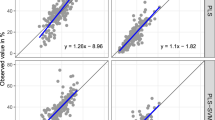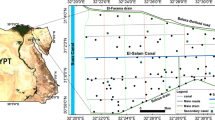Abstract
In this study, we examined the ability of reflectance spectroscopy to predict some of the most important soil parameters for irrigation such as field capacity (FC), wilting point (WP), clay, sand, and silt content. FC and WP were determined for 305 soil samples. In addition to these soil analyses, clay, silt, and sand contents of 145 soil samples were detected. Raw spectral reflectance (raw) of these soil samples, between 350 and 2,500-nm wavelengths, was measured. In addition, first order derivatives of the reflectance (first) were calculated. Two different statistical approaches were used in detecting soil properties from hyperspectral data. Models were evaluated using the correlation of coefficient (r), coefficient of determination (R 2), root mean square error (RMSE), and residual prediction deviation (RPD). In the first method, two appropriate wavelengths were selected for raw reflectance and first derivative separately for each soil property. Selection of wavelengths was carried out based on the highest positive and negative correlations between soil property and raw reflectance or first order derivatives. By means of detected wavelengths, new combinations for each soil property were calculated using rationing, differencing, normalized differencing, and multiple regression techniques. Of these techniques, multiple regression provided the best correlation (P < 0.01) for selected wavelengths and all soil properties. To estimate FC, WP, clay, sand, and silt, multiple regression equations based on first(2,310)-first(2,360), first(2,310)-first(2,360), first(2,240)-first(1,320), first(2,240)-first(1,330), and raw(2,260)-raw(360) were used. Partial least square regression (PLSR) was performed as the second method. Raw reflectance was a better predictor of WP and FC, whereas first order derivative was a better predictor of clay, sand, and silt content. According to RPD values, statistically excellent predictions were obtained for FC (2.18), and estimations for WP (2.0), clay (1.8), and silt (1.63) were acceptable. However, sand values were poorly predicted (RDP = 0.63). In conclusion, both of the methods examined here offer quick and inexpensive means of predicting soil properties using spectral reflectance data.



Similar content being viewed by others
References
Antonucci, F., Menesatti, P., Holden, N. M., Canali, E., Giorgi, S., Maienza, A., et al. (2012). Hyperspectral visible and near-infrared determination of copper concentration in agricultural polluted soils. Communications in Soil Science and Plant Analysis, 43, 1401–1411.
Bengtsson, S., Berglöf, T., & Kylin, H. (2007). Near infrared reflectance spectroscopy as a tool to predict pesticide sorption in soil. Bulletin of Environmental Contamination and Toxicology, 78(5), 295–298.
Bilgili, A. V., Van Es, H. M., Akbas, F., Durak, A., & Hively, W. D. (2010). Visible-near infrared reflectance spectroscopy for assessment of soil properties in a semi-arid area of Turkey. Journal of Arid Environments, 74, 229–238.
Bilgili, A. V., Cullu, M. A., Van Es, H. M., Aydemir, A., & Aydemir, S. (2011). The use of hyperspectral visible and near infrared reflectance spectroscopy for the characterization of salt-affected soils in the Harran Plain, Turkey. Arid Land Research and Management, 25(1), 19–37.
Bogrekci, I., & Lee, W. S. (2005a). Spectral soil signatures and sensing phosphorus. Biosystems Engineering, 92, 527–533.
Bogrekci, I., & Lee, W. S. (2005b). Spectral phosphorus mapping using diffuse reflectance of soils and grass. Spectral soil signatures and sensing phosphorus. Biosystems Engineering, 91(3), 305–312.
Bouyoucos, G. H. (1951). A recalibration of the hydrometer for making mechanical analysis of soils. Agronomy Journal, 43, 438.
Chakraborty, S., Weindorf, D. C., Zhua, Y., Li, B., Morganc, C. L. S., Gec, Y., et al. (2012). Spectral reflectance variability from soil physicochemical properties in oil contaminated soils. Geoderma, 177–178, 80–89.
Chang, C. W., Laird, D. A., Mausbach, M. J., & Hurburgh, C. R. (2001). Near-infrared reflectance spectroscopy-principal components regression analyses of soil properties. Soil Science Society of America Journal, 65, 480–490.
Chang, C. W., Laird, D. A., & Hurburgh, G. R. (2005). Influence of soil moisture on near-infrared reflectance spectroscopic measurement of soil properties. Soil Science, 170, 244–255.
Cheng, B., & Wu, X. (2006). A modified PLSR method in prediction. Journal of Data Science, 4, 257–274.
Chodak, M., Niklinska, M., & Beese, F. (2007). Near-infrared spectroscopy for analysis of chemical and microbiological properties of forest soil organic horizons in a heavymetal-polluted area. Biology and Fertility of Soils, 44, 171–180.
Cozzolino, D., Cynkar, W., Shah, N., & Smith, P. (2011). Quantitative analysis of minerals and electric conductivity of red grape homogenates by near infrared reflectance spectroscopy. Computers and Electronics in Agriculture, 77, 81–85.
Debaene, G., Niedźwiecki, J., & Pecio, A. (2010). Visible and near-infrared spectrophotometer for soil analysis: preliminary results. Polish Journal of Agronomy, 3, 3–9.
Debaene, G., Niedźwiecki, J., Pecio, A., & Żurek, A. (2014). Effect of the number of calibration samples on the prediction of several soil properties at the farm-scale. Geoderma, 214, 114–125.
Demattê, J. A. M., Sousa, A. A., Alves, M. C., Nanni, M. R., Fiorio, P. R., & Campos, R. C. (2006). Determining soil water status and other soil characteristics by spectral proximal sensing. Geoderma, 135, 179–195.
Dunn, B. W., Beecher, H. G., Batten, G. D., & Ciavarella, S. (2002). The potential of near-infrared reflectance spectroscopy for soil analysis—a case study from the Riverine Plain of south- eastern Australia. Australian Journal of Experimental Agriculture, 42, 607–614.
Ersahin, S., & Brohi, A. R. (2006). Spatial variation of soil water content in topsoil and subsoil of a Typic Ustifluvent. Agricultural Water Management, 83(1–2), 79–86.
Gomez, C., Lagacherie, P., & Coulouma, G. (2008). Continuum removal versus PLSR method for clay and calcium carbonate content estimation from laboratory and airborne hyperspectral measurements. Geoderma, 148, 141–148.
Hansen, V. E., Israelsen, O. W., & Stringham, G. E. (1980). Irrigation principles and practices (Fourthth ed.). New York: John Wiley & Sons. 417pp.
He, Y., Huang, M., Garcia, A., Hernandez, A., & Song, H. (2007). Prediction of soil macronutrients content using near-infrared spectroscopy. Computers and Electronics in Agriculture, 58, 144–153.
Islam, K., Singh, B., & McBratney, A. (2003). Simultaneous estimation of several soil properties by ultra-violet, visible, and near-infrared reflectance spectroscopy. Australian Journal of Soil Research, 41, 1101–1114.
Jackson, R. D., Pinter, Jr. P. J., Reginato, R. J., & Idso, S. B. (1980). Hand-held radiometry. In: a set of notes developed for use at the workshop on hand-held radiometry, Phoenix, Arizona (Science and Education Administration, Agricultural Reviews and Manuals, Western Series, No. 19) 66 p.
Koksal, E. S. (2011). Hyperspectral reflectance data processing through cluster and principal component analysis for estimating irrigation and yield related indicators. Agricultural Water Management, 98, 1317–1328.
Koksal, E. S., Cemek, B., Artik, C., Temizel, K. E., & Tasan, M. (2011). A new approach for neutron moisture meter calibration: artificial neural network. Irrigation Science, 29, 369–377.
Moron, A., & Cozzolino, D. (2003). Exploring the use of near infrared reflectance spectroscopy to study physical properties and microelements in soils. Journal of Near Infrared Spectroscopy, 11(2), 145–154.
Qiao, L., Chen, L. X., Duan, W. B., Song, R. Q., & Wang, X. F. (2011). Comparison of three multivariate methods of inferential modeling of soil organic matter using hyper spectra. Remote Sensing, Environment and Transportation Engineering (RSETE), International Conference. 8124–8127, Nanjing, China.
Ramos, M. C., & Martínez-Casasnovas, J. A. (2014). Soil water variability and its influence on transpirable soil water fraction with two grape varieties under different rainfall regimes. Agriculture, Ecosystems & Environment, 185(1), 253–262.
Sankey, J. B., Brown, D. J., Bernard, M. L., & Lawrence, R. L. (2008). Comparing local vs global visible and near-infrared (VisNIR) diffuse reflectance spectroscopy (DRS) calibrations for the prediction of soil clay, organic C and inorganic C. Geoderma, 148, 149–158.
Shi, T., Cui, L., Wang, J., Fei, T., Chen, Y., & Wu, G. (2012). Comparison of multivariate methods for estimating soil total nitrogen with visible/near-infrared spectroscopy. Plant and Soil, 366(1–2), 363–375.
Shibayama, M., Takahashi, W., Morinaga, S., & Akiyama, T. (1993). Canopy water deficit detection in paddy rice using a high resolution field spectroradiometer. Remote Sensing of Environment, 45, 117–126.
Sorensen, L. K., & Dalsgaard, S. (2005). Determination of clay and other soil properties by near infrared spectroscopy. Soil Science Society of America Journal, 69, 159–167.
Stevens, A., Udelhoven, T., Denis, A., Tychon, B., Lioy, R., Hoffmann, L., et al. (2010). Measuring soil organic carbon in croplands at regional scale using airborne imaging spectroscopy. Geoderma, 158, 32–45.
Taxonomy, S. (1999). Keys to soil taxonomy (8th ed.). Blacksburg VI: Pocahontas Press.
Vasques, G. M., Grunwald, S., & Sickman, J. O. (2008). Comparison of multivariate methods for inferential modeling of soil carbon using visible/near-infrared spectra. Geoderma, 146, 14–25.
Viscarra Rossel, R. A., Walvoort, D. J. J., McBratney, A. B., Janik, L. J., & Skjemstad, J. O. (2006). Visible, near-infrared, mid-infrared or combined diffuse reflectance spectroscopy for simultaneous assessment of various soil properties. Geoderma, 131, 59–75.
Waes, C., Mestdagh, I., Lootens, P., & Carlier, L. (2005). Possibilities of near infrared reflectance spectroscopy for the prediction of organic carbon concentrations in grassland soils. Journal of Agricultural Science, 143, 487–492.
Westerhaus, M., Workman, J. J., Reeves, J. B., & Mark, H. (2004). Quantitative analysis. 'Near-infrared spectroscopy in agriculture'. Agronomy Monograph No. 44. In K. A. Barbarick, C. A. Roberts, W. A. Dick, J. J. Workman, J. B. Reeves III, L. Al-Amoodi (Eds.), (pp. 133–174). American Society of Agronomy, Inc., Crop Science Society of America, Inc., Soil Science Society of America, Inc.: Madison, WI.
Wetterlind, J., Stenberg, B., & Jonsson, A. (2008). Near infrared reflectance spectroscopy compared with soil clay and organic matter content for estimating within-field variation in N uptake in cereals. Plant and Soil, 302, 317–327.
Yang, H., & Li, J. (2013). Predictions of soil organic carbon using laboratory-based hyperspectral data in the northern Tianshan mountains, China. Environmental Monitoring and Assessment, 185, 3897–3908.
Zornoza, R., Guerrero, C., Mataix-Solera, J., Scow, K. M., Arcenegui, V., & Mataix- Beneyto, J. (2008). Near infrared spectroscopy for determination of various physical, chemical and biochemical properties of Mediterranean soils. Soil Biology & Biochemistry, 40, 1923–1930.
Author information
Authors and Affiliations
Corresponding author
Rights and permissions
About this article
Cite this article
Arslan, H., Tasan, M., Yildirim, D. et al. Predicting field capacity, wilting point, and the other physical properties of soils using hyperspectral reflectance spectroscopy: two different statistical approaches. Environ Monit Assess 186, 5077–5088 (2014). https://doi.org/10.1007/s10661-014-3761-2
Received:
Accepted:
Published:
Issue Date:
DOI: https://doi.org/10.1007/s10661-014-3761-2




